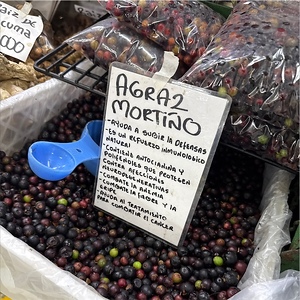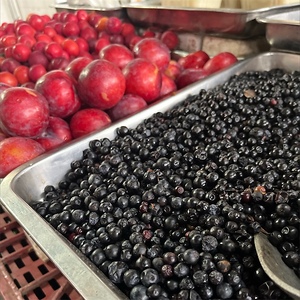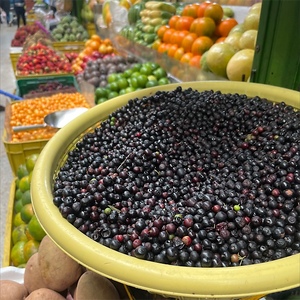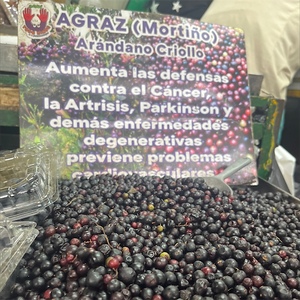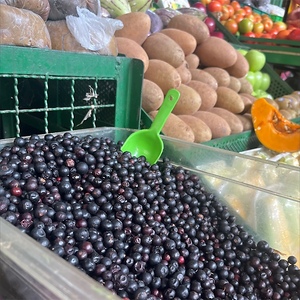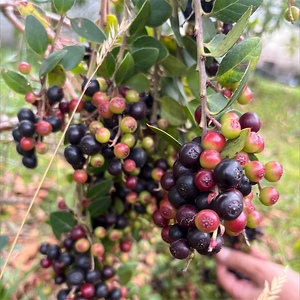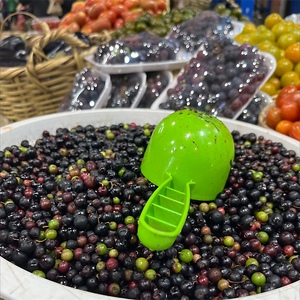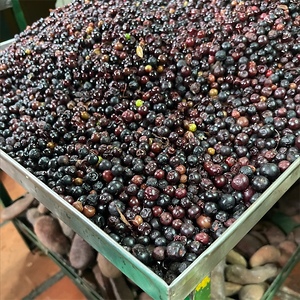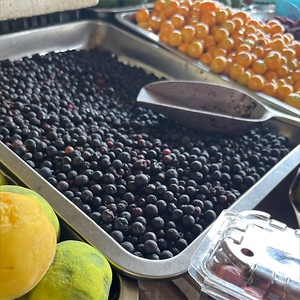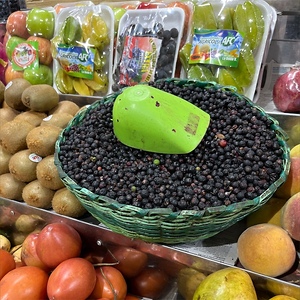


Mortino Berries
Estimated Inventory, lb : 0
Description/Taste
Mortino berries are generally small, averaging 6 to 8 millimeters in diameter, and are round to oval in shape, growing in clusters on low-lying shrubs. The skin of the berry is taut, smooth, and glossy, transitioning from green to many different shades of red during the ripening process, eventually maturing to a dark purple, almost black hue. The skin may also be covered in a light white-gray, waxy bloom depending on the variety. Underneath the surface, the flesh is semi-translucent, aqueous, soft, and pale green, encasing many small and edible, crunchy seeds. Mortino berries have a sweet and savory, herbal flavor that will vary depending on the variety and maturity of each berry. It is common to harvest berries that have a balanced, sweet, and savory taste, while other berries may have an acidic, sour, and astringent flavor.
Seasons/Availability
Mortino berries are harvested for multiple seasons in South America. The berries are gathered in the spring through early summer and again in the fall through winter.
Current Facts
Mortino berries are multi-colored, wild fruits botanically a part of the Ericaceae family. The name Mortino is a general descriptor used throughout South America to describe closely related species of berries found within the Vaccinium genus. The two most prominent species harvested for human consumption are Vaccinium meridionale and Vaccinium floribundum. Mortino berries are found growing wild in the forests of the Andean highlands and are not commercially cultivated. The small berries are harvested by hand and sold in local markets where they are also known as Andean blueberries, Colombian blueberries, Agraz, Vichacha, and Camueza. Mortino berries are favored for their tangy, sweet flavor, and while the berries are primarily localized to South America, the antioxidant-dense fruits are increasing in popularity as a potentially valuable, superfood export.
Nutritional Value
Mortino berries are an excellent source of anthocyanins, which are the colored pigments found in the skin that have antioxidant and anti-inflammatory properties. The berries are also an excellent source of vitamins A and C, which help boost the immune system by protecting the body against external environmental aggressors. In addition to antioxidants, the berries are high in potassium, calcium, phosphorus, and magnesium and contain smaller amounts of copper, manganese, and iron.
Applications
Mortino berries are best suited for both raw and cooked applications such as baking and boiling. The fruits can be washed and consumed straight, out-of-hand as a snack, tossed into green and fruit salads, used as a fresh topping over ice cream, cereals, and yogurt, blended into drinks and smoothies or mixed into honey. It is important to note that while the berries can be consumed raw and are used in the above applications, the fruits will significantly vary in flavor depending on the variety and degree of ripeness. It is impossible to control the taste of wild-growing fruits. Beyond fresh eating, Mortino berries are popularly sweetened and cooked to develop palatable flavors. The berries can be boiled into sauces, jams, and jellies, fermented into wine, used as a topping on pizza, or baked into pies, cakes, and tarts. Mortino berries can also be dehydrated and mixed into candies, muffins, chocolates, and ice creams. Mortino berries pair well with vanilla, honey, cinnamon, clove, meats such as beef, poultry, and fish, basil, ginger, and citrus. The berries will keep 10 to 14 days when stored in a cool and dark place, such as the refrigerator.
Ethnic/Cultural Info
In South America, Mortino berries are used in a traditional drink known as colada morada during the Dia de Los Difuntos or Day of the Dead celebration. Every November, families throughout South America remember and honor their past loved ones by visiting their gravesites. During this visit, the gravestones are cleaned, the burial site is decorated with flowers, and families consume colada morada in commemoration of their ancestors. Colada morada is a thick beverage made from spices such as cinnamon and clove, sugar, Mortino berries, citrus, vanilla, and herbs. Recipes for the purple-hued drink widely vary, depending on the region, and colada morada is commonly served both warm and cold. Guaguas de pan is also eaten with colada morada, which is a sweet bread that is formed into the shape of small dolls. After the visit to the gravesite, colada morada is consumed throughout the rest of the month in remembrance of the season and ancestors.
Geography/History
Mortino berries are native to high elevation forests of the Andes mountain region spanning across Colombia, Venezuela, Ecuador, Bolivia, and Peru. The berries have been growing wild since ancient times, and in the modern-day, Mortino berries have remained mostly uncultivated, harvested by hand from wild shrubs. Today Mortino berries can be found through local markets, especially in Colombia, and at select health food stores throughout South America.
Recipe Ideas
Recipes that include Mortino Berries. One
| Live Life Nutrition |
|
Andean Blueberry Oatmeal Treats |
| Live Life Nutrition |
|
Andean Blueberry Jelly |



